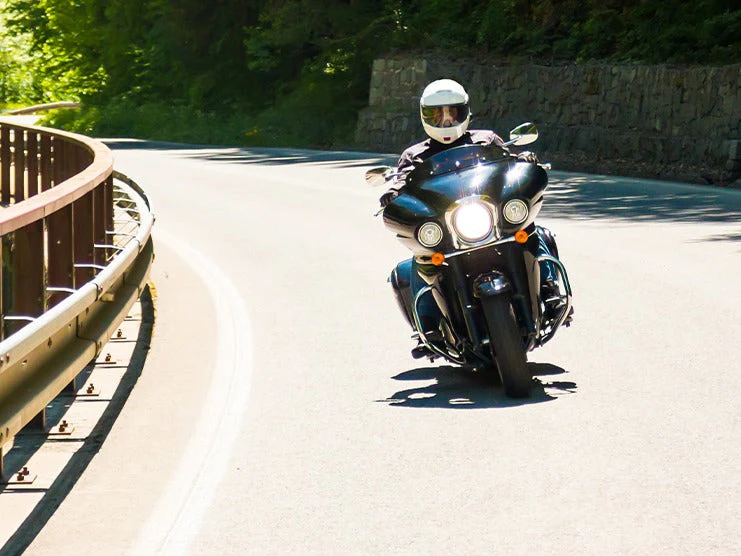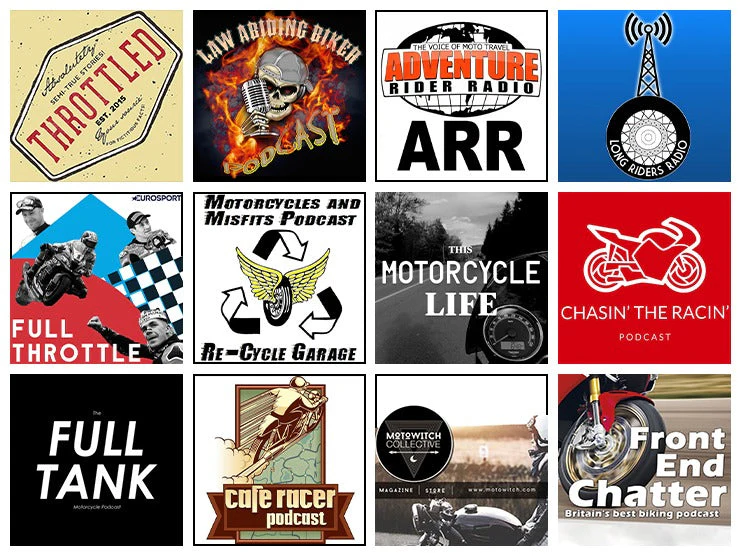All riders must know the basic rules of the road, traffic laws, and road safety. But riding a motorcycle is more than just following rules. When going on a tour, you must also know the rules of riding etiquette.
This article covers the 14 rules of motorcycle touring etiquette.
Table of Content

1. Pay Attention to Hand Signals
It's critical to understand the meaning of hand signals used by the motorcycle community, especially while participating in group rides. Some of these hand signals indicate to go slower, faster, stop, or help another rider. You and your fellow motorcyclists will remain safe on the road if you obey these signals.
Bikers use hand signals to communicate for social and safety reasons. If you see a motorcycle incoming from the opposite lane, see if the rider makes a two-finger salute. The two-finger salute is a way to greet other bikers. You should also give them a salute in return. Avoid being arrogant about it. Salute every rider you see, including those riding scooters.
The helmet tap is a signal that warns of a speed trap or a police car up ahead, allowing you to reduce speed to avoid getting a ticket.
There are also hand signals to indicate turning right, turning left, slowing, stopping, or road hazards ahead. Make sure to use your motorcycle’s blinkers along with your hand signals.
2. Help Other Riders
It's annoying having to pull over onto the side of the road if your vehicle is suffering mechanical problems. It can also be stressful having to stop alongside moving traffic.
Motorcycle touring etiquette dictates that if you see a motorcyclist stranded on the side of the road, you should pull over and assist if you can. Slow down and give stranded riders a thumbs-up sign. If they reply with the same signal, then everything is fine. But if they reply with a thumbs down, they may be struggling with an empty fuel tank, a flat tire, a dead engine, etc. Even if you don’t have mechanical skills, you can still offer to call for roadside assistance or get some fuel. They will value your assistance considerably more because of the common experience of riding motorcycles.
3. Don’t Ride if you are Emotional
If you are feeling angry or depressed, your emotional state may distract you, which can reduce awareness and reaction time when on the road. You must be able to think clearly and pay attention to your surroundings when riding a motorbike.
Riding while upset can cause you to miss traffic signals or warning signs and increase the risk of a collision.
It's best to stay off your motorbike until you're in the correct state of mind.
4. Leave Parking Space for Others
Parking on the sidewalk or in striped areas is prohibited, making it possible to only park your motorcycle in regular parking spaces.
It is possible to park two motorcycles side by side within the same parking space. However, avoid parking your motorcycle right in the middle of a parking space if it prevents another motorcyclist from parking behind or beside your vehicle. If you want to park your motorbike in a regular parking space, move your vehicle a bit to the side to make room for another rider to park next to you. Doing so will also keep you safe from the aggravation of seeing shoe prints, grime, and scuffed-up seats on your bike.
5. Make Sure Your Passenger Has a Helmet
Motorcycle riding etiquette also includes considering your safety and the safety of your passenger. Making sure your passenger always wears a helmet is one of the most important aspects of riding etiquette when you are sharing your bike with another person.
Wearing a motorcycle helmet will help reduce the risk of you and your passenger suffering severe or fatal injuries. As the rider, it is your responsibility to ensure your passenger’s safety by making sure s/he is wearing a helmet. Even if you live in a state without mandatory helmet laws, always encourage your passenger to wear a helmet. If your passenger suffers injuries during an accident, you may suffer the consequences
6. Keep Your Skill Level in Mind
When going on a motorcycle tour, always remember your limits when it comes to your riding skills. Ride at a comfortable speed, don't overextend yourself, and never pull off maneuvers you are not used to trying, like turning at high speed, sudden braking, etc.
If you are still a novice rider, try to practice safety habits by constantly checking your surroundings and riding defensively.
7. Wave at Other Riders
You are automatically a member of the motorcycle community if you ride a motorbike. The wave is there for decent riders to appreciate one another.
Waving at other motorcyclists is a polite way to greet and support them. Motorcycle riders who wave at each other can be friends, family, or complete strangers. Some people believe it's because they are friends or connected in some other way. In fact, whether or not they know each other, motorcycle riders must wave at one another when passing each other on the road out of courtesy.
There are many different types of waves depending on the brand and model of the motorcycles being ridden. The most common wave among motorcyclists is the lower left-hand wave. You do this by simply hanging your left hand low and pointing the inside of your palm in the direction of the other rider.
8. Avoid Unnecessary Revving
There are right and wrong times and places to rev your motorcycle’s engine.
A right time and place to rev the engine would be at a motorcycle rally or show. Meanwhile, the wrong time and place to rev the engine would be in a neighborhood late at night.
While touring, it's proper etiquette to know when is or when isn’t the appropriate time to rev the engine.
Certain cities have noise laws regarding the minimum volume your motorcycle’s engine can make. Revving the engine loudly or unnecessarily could result in someone calling the cops on you.
9. Inform Your Passenger to Limit Movement
Let’s talk about touring etiquette when you are riding with a passenger. There are a few things to follow to make yourself and the passenger feel safe.
Before getting on the road, inform the passenger to limit the movement while on the motorcycle. It may be difficult to maintain balance if the passenger keeps making adjustments. Pay attention in case your passenger asks you if it is alright for him/her to move. At times when it is safe to do so, you can use hand signals to tell your passenger it is safe to move. When your passenger is changing position, slow down and try to ride in a straight line. Making sure to limit your passenger’s movements will lower the risk of crashing.
10. Avoid Quick Acceleration with a Passenger
Most motorcycles are built with powerful engines that ensure smooth handling, but you should still be careful to avoid accelerating suddenly out of consideration for your passenger.
Suddenly accelerating without warning could cause your passenger to fall backward off your motorcycle. Make sure to tell your passenger what is coming so they are prepared to hold on tight.
11. Don’t Make Sharp Turns with a Passenger
While riding a motorbike alone, you could be brave to do some things, but that doesn't imply your passenger is equally at ease with it. Avoid making sudden turns while riding with a passenger. Passengers may become scared if you attempt risky sharp turns without informing them. If you must make a quick turn, let the passenger know in advance so s/he can be ready.
12. Never Assume You Can Share a Lane
You may have also seen that bikers occasionally engage in a practice known as "lane sharing." When two motorcycles are going virtually side-by-side in the same lane on a road, this is referred to as lane sharing. In order to take up less space on the road, this is typically done when a group of motorcycle riders rides together.
Never assume you can share a lane with another rider, especially if you don't know the individual. Also, some states have deemed lane sharing illegal which is why it is recommended you review the local road laws.
Lane sharing is illegal in certain places, so before you even consider doing it with anyone, make sure you are aware of the local regulations in your area.
13. Avoid Riding on Metal
Try to avoid riding over metal construction plates and manhole covers. Riding over a manhole cover at high speed is almost as bad as hitting a pothole.
When you ride over these metal plates, their edges might create an uneven surface that may create bumps in the road. The steel surface may also become highly slippery when wet. Make sure to research your intended route to see if there are construction sites you need to avoid since metal plates are often near such locations.
14. Do Not Assume All Drivers Can See You
When riding, do not assume other drivers can see you even if you are not in their blindspots. Due to motorcycles having slim frames and being highly maneuverable, it is easy for riders to disappear from the view of the rearview mirrors. When traveling behind or trying to pass other vehicles, make sure to maintain a safe distance and be ready to get out of the way in case the surrounding vehicles start to turn into you.
15. Last Words
As a motorcycle rider, it is your duty to know all the written and unwritten rules of the road. Most riders focus on following road safety and traffic laws but neglect riding etiquette. Proper touring etiquette includes using hand signals, helping other riders, leaving parking space for others, waving at other riders, and riding at your skill level. If you are riding with a passenger, avoid quickly accelerating and making sharp turns. If you are facing motorcycle storage issues then you should buy motorcycle luggage like saddlebags, tank bags, sissy bar bags, and backpacks.













Leave a comment
All comments are moderated before being published.
This site is protected by hCaptcha and the hCaptcha Privacy Policy and Terms of Service apply.